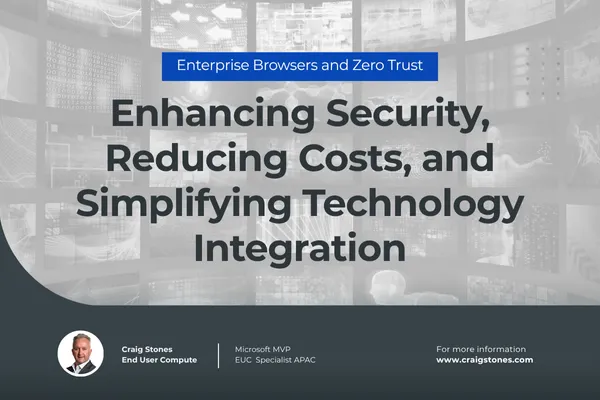
Enterprise Browsers and Zero Trust: Enhancing Security, Reducing Costs, and Simplifying Technology Integration
I want to unpack a topic that’s creating ripples across the enterprise IT landscape—enterprise browsers. If you’re in IT leadership, you’ve likely heard murmurs of a shift towards leveraging these futuristic browsers for better security, cost efficiency, and seamless integration.
But what really are enterprise browsers, and why should CIOs, CTOs, and even CEOs care? Grab your cuppa—this is worth a read, especially if terms like “zero trust” and “total cost of ownership” mean anything to your organisation.
What on Earth Are Enterprise Browsers?
Before you start imagining something exotic—it’s not. Enterprise browsers are, at their core, just like the browsers we all use every day (think Edge or Chrome). The difference? These browsers are engineered from the ground up to prioritise security, functionality, and enterprise-wide control—all without compromising speed or user experience. With solutions like Island, these tools are changing how businesses safeguard their workflows and empower users.
To put it simply, enterprise browsers ensure that every click, every sign-on, and every SaaS app is wrapped in a secure layer. Enterprise-grade baked-in security connects single sign-on capabilities with zero trust principles, ticking off both compliance needs and usability.
For instance, an employee can log in through multi-factor authentication, open an enterprise browser, and seamlessly access their apps like Salesforce or monday.com—whether they’re at the office, at home, or working from a coffee shop in Melbourne.
Why Enterprise Browsers Are a CIO’s New Best Mate
1. Zero Trust Built Right
Traditional browser systems often can’t scale to meet zero trust requirements. Island, however, flips this on its head. Everything accessed via the browser, whether it’s SaaS or legacy Windows apps, adheres to strict zero trust frameworks—minimising vulnerabilities and blocking unauthorised access seamlessly.
Instead of relying on an ecosystem of separate tools like endpoint security, third-party platforms, and VPNs, enterprise browsers position themselves as a one-stop shop. This removes layers of complexity, reducing risk without adding new headaches.
CIO Takeaway
This moves the organisation light-years ahead of relying on older models of perimeter-based security. Compliance? Handled. Integration with existing directories like Azure AD? Effortless.
2. Plug and Play With Existing Tech
Here’s the beauty of enterprise browsers like Island—they don’t demand you overhaul your entire IT stack. Already running Citrix, Imprivata, or IGEL? You’re set.
From healthcare deployments that give staff secure access to patient data via devices like IGEL endpoints, to traditional enterprise workloads, enterprise browsers integrate smoothly into your ecosystem without disturbing your legacy solutions.
Instead of creating conflict with IT infrastructure, Island enhances compatibility with existing tech stacks. Whether you're running hybrid cloud, VDI, or even legacy apps, this is a solution designed to rotate in as your next logical step—not a cumbersome leap.
CTO Takeaway
Want a secure browser that plays nicely with your Citrix or AVD environments? Island has been rigorously tested to prove exactly this. Teams don’t need to reinvent the wheel to scale securely—whether you’re managing a five-user office or a 20,000-seat organisation.
3. Lower Total Cost of Ownership (TCO)
Think about what’s potentially draining your IT budget—expensive third-party security tools, high licensing fees, and complex tech stacks involving redundant features. Moving to an enterprise browser takes that weight off your shoulders.
A unified solution like Island cuts down on unnecessary tools such as endpoint monitoring software or redundant secure gateways. The result? Sizable cost savings, fewer service tickets, and fewer nightmares for your IT ops team.
CEO Takeaway
Your IT department will give you numbers, but here’s the simplest way to frame it—cost down, security up, and resources freed.
Who Is Enterprise Browsing Really For?
It’s easy to assume new technologies require enterprise-scale adoption only. But the reality is this—Island scales both ways. From lean teams of five to sprawling organisations spanning continents, it’s built to serve businesses of every size.
For healthcare executives, government agencies, or SMB managers looking to avoid the "rip and replace" overhaul, enterprise browsing offers a unique way to clear tech debt while meeting new demands.
“The simplicity of enterprise browsers lies in their ability to create secure, reliable, plug-and-play ecosystems for today’s hybrid workforce.”
Time to Rethink Your Toolkit?
At Teba, we’re driven by technology that delivers real-world value, solving practical challenges without fluff. When we talk about enterprise browsers, it’s not about pitching another shiny IT tool—it’s about solving something profound:
End-users get efficient, secure access.
CIOs see simplified deployment and reduced risk.
CEOs enjoy efficient cost savings that enhance revenue goals.
If you want to know more about this new frontier—zero trust enterprise browsers like Island—drop me a line. Whether you’re on the fence, curious, or want to dive in immediately, I’d love to hear your thoughts.
